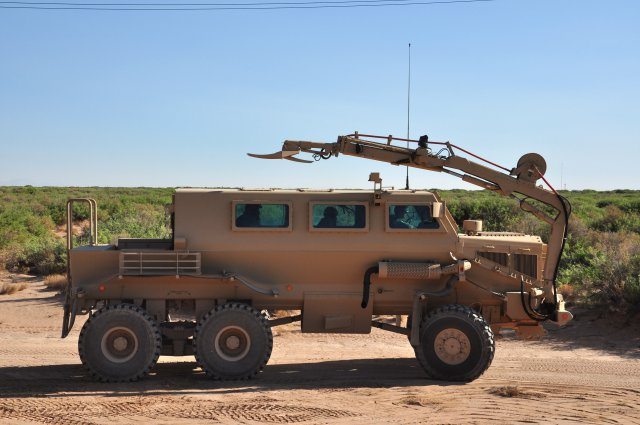Two vehicles used by multiple units in the military to assist in clearing routes and marking improvised explosive devices have made their way to the 2nd Brigade, 1st Armored Division, Special Troops Battalion, here.
The unit is using these vehicles in various training exercises during the Army’s six-week Network Integration Evaluation, or NIE, at White Sands Missile Range, N.M.
The Husky Mounted Detection System, a vehicle with ground penetrating radar capable of detecting buried improvised explosive devices, or IEDs, and anti-tank land mines, and the Buffalo Armored Vehicle, a mine-resistant, ambush-protected, or MRAP, vehicle, are designed to safely clear routes in dangerous combat environments.
The introduction of new vehicles and equipment into a unit can often create growing pains, however many Soldiers in the Special Troops Battalion, or STB, are familiar with or have had combat experience with both vehicles.
“We have experienced senior noncommissioned officers and Soldiers who have knowledge of the vehicles’ fundamentals prior to them coming to our unit,” said 2nd Lt. David McDonald, 1st Platoon Leader, Company C, 2/1 STB.
McDonald, went on to explain the importance of having these vehicles in Company C.
“Our command really pushed to have equipment available to our unit,” he said. “The addition of the Huskies and Buffaloes, as well as the (mine) rollers, completes the company’s capability to conduct its mission.”
Company C is the only company in the brigade to have these vehicles in its inventory. The Combat Engineers of Company C will use these vehicles as part of their route clearing missions while deployed in theater. These missions will allow freedom of movement for allied forces as well as local civilians.
To better operate in combat situations, the Soldiers of Company C need realistic training. The NIE provides the unit with that training.
“Today my team did a deliberate clearance (of a route),” said Spc. Nicholas Wyant, a team leader assigned to 1st Platoon, Company C. “We used the Buffalo to interrogate and investigate suspected IEDs. My Soldiers told me (after the training) they really felt safe inside the vehicle.”
Wyant said the training at White Sands Missile Range is as close to real-life combat experience he and his Soldiers can get short of actually deploying.
The unit is in the initial stage of the NIE and understands the importance of receiving as much hands-on vehicle and equipment training before deploying into actual combat situations. The vast mountains and desert-like terrain at White Sands Missile Range create various line-of-sight and non-line-of-sight challenges, making it the perfect environment for Soldiers to train while evaluating new capabilities.
“We took advantage of (NIE) to be able to get the unit extra training,” McDonald said. “It’s difficult to get six weeks cleared in Garrison to be able to do what we do.”
By the end of the NIE, McDonald expects Company C will be technically proficient, have the added confidence to deploy immediately, and know the ins and outs of various route clearing procedures being conducted during the exercise.
“This training is highly important,” he added. “Here we can implement out TTP’s, (tactics, techniques, and procedures) so we’ll be able to help Soldiers and ultimately save lives.”










